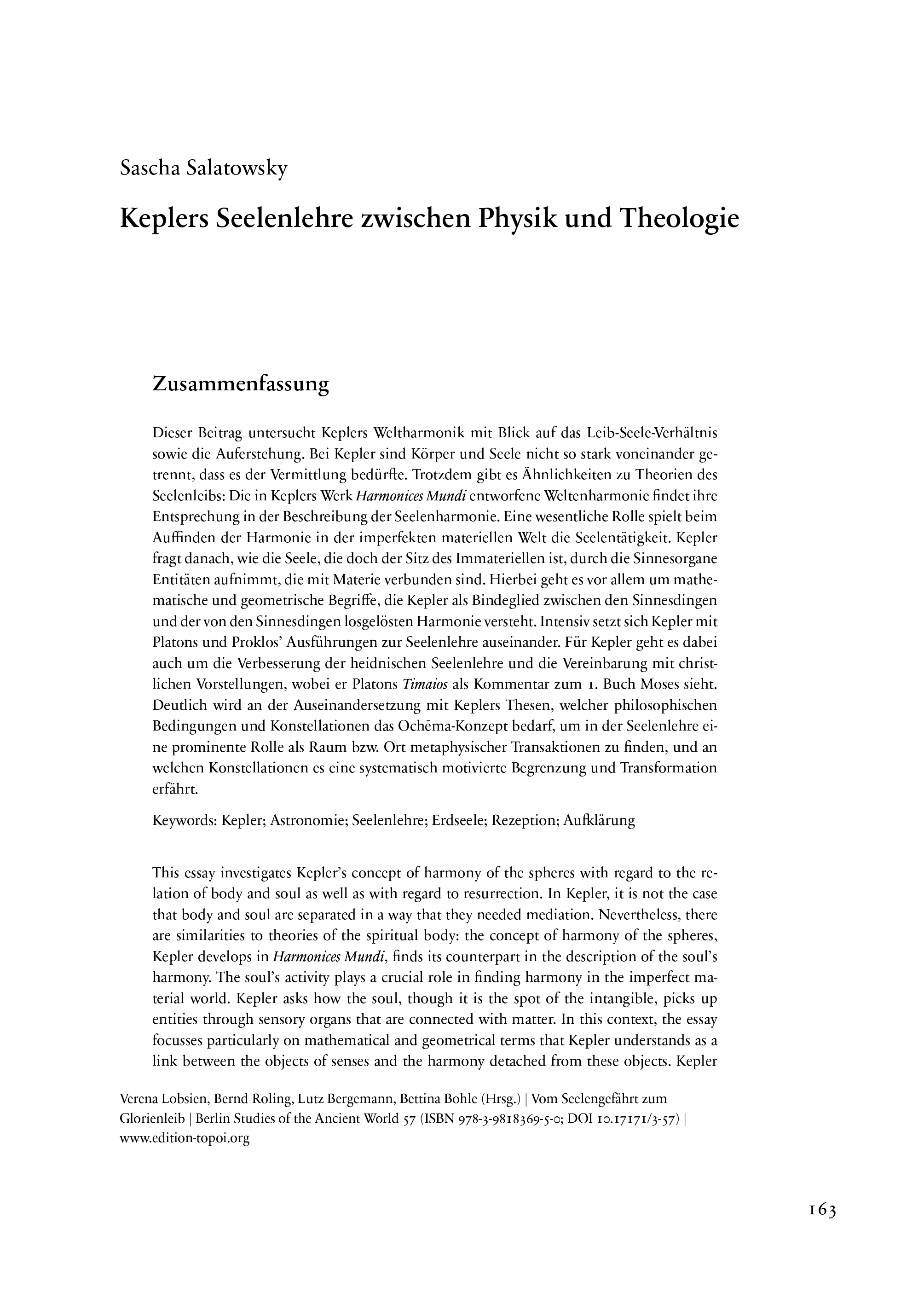Keplers Seelenlehre zwischen Physik und Theologie
This essay investigates Kepler’s concept of harmony of the spheres with regard to the relation of body and soul as well as with regard to resurrection. In Kepler, it is not the case that body and soul are separated in a way that they needed mediation. Nevertheless, there are similarities to theories of the spiritual body: the concept of harmony of the spheres, Kepler develops in Harmonices Mundi, finds its counterpart in the description of the soul’s harmony. The soul’s activity plays a crucial role in finding harmony in the imperfect material world. Kepler asks how the soul, though it is the spot of the intangible, picks up entities through sensory organs that are connected with matter. In this context, the essay focusses particularly on mathematical and geometrical terms that Kepler understands as a link between the objects of senses and the harmony detached from these objects. Kepler intensively discusses Plato’s and Proclus’ teachings of the soul. For him, this also involves improvement of the heathen teaching of the soul and a compromise with Christian concepts, whereupon he reads Plato’s Timaios as a comment on the First Book of Moses. The discussion of Kepler’s theses shows which philosophical conditions and constellations the concept of ochema requires in order to play a prominent role as space or respectively place of metaphysical transactions. In this regard, the discussion also highlights the constellations in which the concept of ochema has to be modified due to systematically motivated restrictions and transformations.
Dieser Beitrag untersucht Keplers Weltharmonik mit Blick auf das Leib-Seele-Verhältnis sowie die Auferstehung. Bei Kepler sind Körper und Seele nicht so stark voneinander getrennt, dass es der Vermittlung bedürfte. Trotzdem gibt es Ähnlichkeiten zu Theorien des Seelenleibs: Die in Keplers Werk Harmonices Mundi entworfene Weltenharmonie findet ihre Entsprechung in der Beschreibung der Seelenharmonie. Eine wesentliche Rolle spielt beim Auffinden der Harmonie in der imperfekten materiellen Welt die Seelentätigkeit. Keplerfragt danach, wie die Seele, die doch der Sitz des Immateriellen ist, durch die Sinnesorgane Entitäten aufnimmt, die mit Materie verbunden sind. Hierbei geht es vor allem um mathematische und geometrische Begriffe, die Kepler als Bindeglied zwischen den Sinnesdingen und der von den Sinnesdingen losgelösten Harmonie versteht. Intensiv setzt sich Kepler mit Platons und Proklos’ Ausführungen zur Seelenlehre auseinander. Für Kepler geht es dabei auch um die Verbesserung der heidnischen Seelenlehre und die Vereinbarung mit christlichen Vorstellungen, wobei er Platons Timaios als Kommentar zum 1. Buch Moses sieht. Deutlich wird an der Auseinandersetzung mit Keplers Thesen, welcher philosophischen Bedingungen und Konstellationen das Ochēma-Konzept bedarf, um in der Seelenlehre eine prominente Rolle als Raum bzw. Ort meta-physischer Transaktionen zu finden, und an welchen Konstellationen es eine systematisch motivierte Begrenzung und Transformation erfährt.

